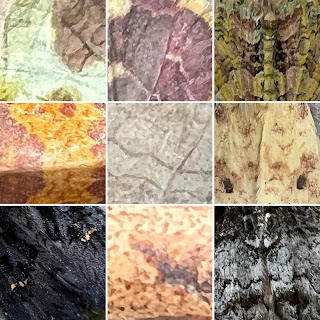Tuesday 27 September 2022
Orange drops
Friday 23 September 2022
Fresh and new
The year advances but these sunny September days are excellent for butterflies, many of them freshly hatched, the second generation of 2022. The male Common Blue, above, is an example and here's the underside of one of its relatives, below, also on our Michaelmas Daisies which are a terrific bee and butterfly magnet.
Ditto this Red Admiral which was nectaring so happily on flowering ivy that it was easy to creep up and get a close-in photo. After a while, it skimmed off and did a bit of posing for the the people who look after our canal.
Monday 19 September 2022
Delicately done
A new moth in my garden is a rarity these days, after nearly ten years of running the light trap here. One such has just arrived however, the softly-coloured Delicate Moth which is an immigrant from the Continental mainland and sometimes beyond. Scientists believe that the paler the example, the warmer the climate where it spent its egg, caterpillar and chrysalis years, In which case, this one may be a native of the Mediterranean, perhaps even the north coast of Africa.
Immigrant moths are particularly likely to arrive at this time of year, adding a belated morsel of Summer excitement to early Autumn days during which P and I carry out such tasks as harvesting our spuds and bagging a good share for the Food Bank.
Monday 12 September 2022
Autumn colour
We're just getting the first hints of genuine Autumn here, as opposed to the 'fake' version which seemed to be coming with all the prematurely falling, drought-stricken leaves. This means the prospect of vivid colours in the next month or so, but the butterfly world is not waiting until then.
The Red Admirals are emerging in their end of Summer brood. Isn't it marvellous that one of our commonest butterflies is as magnificent as this newly hatched specimen on our Michaelmas Daisies, one of their favourite nectaring flowers? The black-and-white rim to the wings, a delicatefeature of most UK butterfly species when new, is pretty much undamaged and the colours blazing. What a treat!
Thursday 8 September 2022
Butterfly - or moth?
 The Vapourer is a fierce-looking moth with various distinctions: it has a very fine caterpillar which I once met while working on my grandchildren's treehouse, the female is flightless and resembles a woodlouse and the male, which is quite a good-sized insect, flies by day as well as night. This last characteristic has led to another interesting phenomenon: it is quite often mistaken for a Brown Hairstreak butterfly and vice-versa.
The Vapourer is a fierce-looking moth with various distinctions: it has a very fine caterpillar which I once met while working on my grandchildren's treehouse, the female is flightless and resembles a woodlouse and the male, which is quite a good-sized insect, flies by day as well as night. This last characteristic has led to another interesting phenomenon: it is quite often mistaken for a Brown Hairstreak butterfly and vice-versa.























































